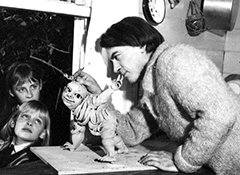
Click an Image below to Enlarge
“He painted every picture as though
it were his last.”*
John Perceval (1923-2000) was an
outstanding painter within a generation of visionary Australian artists. Like his contemporaries and friends, Arthur
Boyd (1920-99) and Sidney Nolan (1917-92), Perceval was one of the most
original landscape painters of the post-war period in Australia. During the now infamous forties in Melbourne,
Perceval was very much a part of the avant-garde group of visionary artists
that gathered and shared ideas at the Melbourne home, ‘Heide’ belonging to the
ambitious and influential art collectors John (1901-81) and Sunday Reed
(1905-81). To say this group comprising
Perceval, Boyd, Nolan together with other icons of Australian modern art,
Albert Tucker (1914-99), Charles Blackman (1928-2018) and Joy Hester (1920-60),
‘revolutionised’ Australian art is an understatement. These artists became known as the ‘Angry
Penguins’ and ‘Rebels and Precursors’ and were to irrevocably change the nature
of art in Australia. Perceval was among the youngest exhibitors at the
Contemporary Art Society, first included at age nineteen.
Perceval led a complex and tragic
life, marred by illness and alcoholism.
Born Linwood Robert Stevens South in Western Australia in 1923, Perceval
spent the first twelve years of his life on his father’s wheat farm. His mother then brought him to Melbourne, and
he assumed his stepfather’s name, so becoming John Perceval. At the age of fifteen Perceval fell victim to
polio and spent a year bedridden. His fondness
for drawing and painting was consolidated whilst his activities were so limited
during his recovery. He later met Arthur Boyd during his service in the army,
his gateway to the Melbourne artists that gathered at Heide. In 1944, Perceval married Mary Boyd (sister
of Arthur) though Mary subsequently married Nolan.
Perceval painted little that might
be considered strictly landscape until relatively late in his career. It wasn’t until 1956 that he concentrated his
interest on the landscape subject.
During the early fifties Perceval almost stopped painting altogether,
and certainly didn’t produce any major works.
He emerged with an entirely new approach to painting: ebullient and
reinvigorated, motivated and technically governed by emotion. The confident hand of the mature artist
evident in every paint laden stroke.
During the late fifties Perceval was awarded many of Australia’s most
important art prizes. In 1958 he was
awarded the National Gallery of Victoria’s ‘John McCaughey Prize and in 1960 he
won the prestigious Wynne Prize in 1960 (shared with Laurence Scott Pendlebury
(1914-1986)). By the sixties Perceval
was a huge critical and financial success.
His painting ‘Sulphur Smoke’ 1959 from his early Williamstown series was
in 2000 the highest selling artwork by an Australian living artist.
Perceval famously worked outdoors,
tending most often toward landscapes of the Australian bush with dense
undergrowth in locales around Melbourne and Victoria. As Perceval reflects with rich insight into
his practice:
“At times my work is primarily a
response to the subject, to light and trees, air, people etc. Whatever success
it may achieve is due to a desire to equate the vitality, the pulse of life in
nature and the world around us.” **
That ‘pulse’, that essential life force is at the nexus of Perceval’s oeuvre across a career spanning five decades.
*John Brack cited in Plant,
Margaret, ‘John Perceval 1923-2000’, Art
and Australia, np.
**John Perceval cited in Reed, J.,
‘New Painting 1952-62’, The Arts in Australia Series, Longmans 1963,
p.28
Copyright © 2007 Abstract Australis. All rights reserved. Click here to view copyright statement